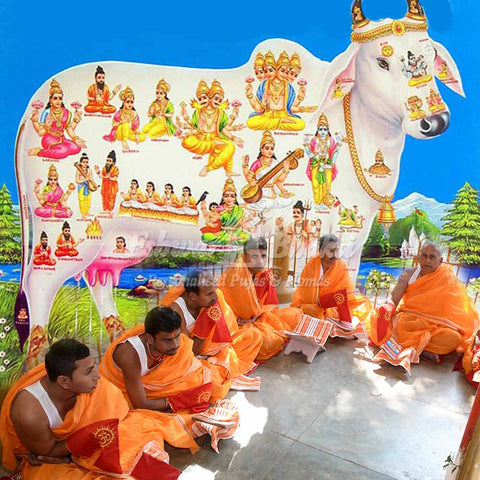What is Achamanam?
 Achamanam is a ritual in Hinduism to purify our minds and bodies. The purification process includes sipping water from our right hand with the recitation of different mantras. These mantras are known to invoke power and energy when we correctly chant them. There are different types of Achamanam performed in Hindu culture based on which we can classify them into three. They are-
Achamanam is a ritual in Hinduism to purify our minds and bodies. The purification process includes sipping water from our right hand with the recitation of different mantras. These mantras are known to invoke power and energy when we correctly chant them. There are different types of Achamanam performed in Hindu culture based on which we can classify them into three. They are-
1. Srautacamanam - It follows the instructions for performing Achamana as per the Vedas. Here, you may sip water thrice by reciting the three Pathas of the Gayathri mantra in succession. You may begin by chanting 'Om Achutaya Namaha' to the water in your right hand. It can energize the water. You can then continue doing the same twice by chanting,' Om Anantaya Namaha' and 'Om Govindaya Namaha.' In the second half of Srautacamanam, you have to touch twelve parts of the body while chanting the nine Abhilingas and the seven Vyahutis.
2. Smrtyacamanam - It follows the Dharmasutras and bases itself on the Smritis. Here, a devotee may sip the water thrice, with the recitation of 'Svaha.' Then, you may touch the nine parts of your body with the utterance of the Sutras.
3. Puranacamanam - A devotee performs it by chanting the 24 names of Lord Vishnu. Here, you may hold the water in your right hand (chant - Om Aarchamyaa), sip it thrice while chanting Om Keshavaya Svaha, Om Narayanaya Svaha, and Om Madhavaya Svaha. For the next two recitations, Om Govindaya Namaha and Om Vishnave Namaha, you may wash your hands. For the following nineteen names, you have to touch different body parts with your right hand. Puranancamanam is a process that aids in the purification of physical and mental impurities.
The performance of Achamanm at the beginning of all Vedic rituals and pujas can induce energy and provide us with internal as well as external purification.
Significance of performing Achamanam: Different Paramparas have distinct methods of performing Achamanams. For instance, Goudi Vaishnavas are known to perform Achamanams as taught in Pachartra Prabudha. Similarly, Achamanams have different religious and scientific significances of practicing it.
Religious significance: Achamanam is a purification process done with the aid of water. The water used for Achamanam has to be pure without any odor. You can use Panchaptra with a spoon to pour water into your right hand. The recitation of mantras is a necessary factor while performing Achamanams. They can foster your spiritual enrichment. Let us look at Achamanam in a religious dimension based on scriptures and epics.
1. In Ramayana, Lord Rama performed Achamanam thrice by chanting Adhithya Hrudhya mantra before he eliminated Ravana. The chanting of the mantra gave him the power to remove Ravana.
2. In the eleventh Skandha of Devi Bhagavata, drinking water from the right palm curved in the shape of a spoon is auspicious. The water in your hands must be able to cover a green-gram seed. Our palm, little finger, and thumb must not come in contact with other fingers. You can support your right hand with your left hand while performing Achamanam. It can purify your body of any impurities.
3. In Sivapurana, Achamanam is a way of worshipping the phallic image.
4. In Natyashastra, the performance of Achamanam at the end of the day can ward off the hardships and evil forces from our lives. It also facilitates the installation of god.
5. As per Santana Dharma, the performance of Achamanam can provide internal and external purification. It can stimulate the mind to remove evil forces from within.
6. Performance of Achamanam before applying Tilaka and having Prasada can enhance our spiritual growth.
Scientific significance: There are five main elements or Panchabhootas in our bodies. They include air, water, wind, fire, earth, and ether or space. Their balanced existence aids in the proper flow of bio-electricity through our bodies. Each of our fingertips is associated with one element (thumb-fire, index finger-wind, middle finger-ether, ring finger- earth, and little finger-water). The performance of Achamana invokes the vitalities of these elements through our fingertips.
The asana of practicing Achamanam is Kukutasana. Here, we put pressure on the toes, which aids in the proper functioning of the thyroid, the pituitary, and the adrenal gland.
When can you perform Achamanam? : You can perform Achamanam preliminary to daily rituals like Brahmayagyam, mantra chanting, Sandhya Vandhanam. You can also practice them -
• after the acceptance or giving of alms
• before and after crossing a river
• before and after taking a bath
• soon after waking up
• after brushing your teeth
• before and after a meal
A devotee has to perform Achamananam in a clean place facing East or North. One has to sip water through Brahma Theertha and don't make any sound while drinking the water as it is disrespectful.
When not to perform Achamanam? : There are different instances when you are not supposed to perform Achamanam. Here, we will be discussing some of the situations when you cannot perform Achamanam. They are -
• when the Shika is not tied
• when you have your head covered
• when you are wearing footwear
• when you are standing
• when you are wearing dirty clothes
• when you are wearing a Pavitram
• when you have just taken Prasaham or sipped Teertha
You don't have to perform Achamanam if you have had betel leaf, soma pana, sugarcane piece, or mango. You have to perform Achamanam with complete devotion. The practice of Achamanam can enhance you physically, psychologically, and emotionally. It facilitates the balancing of the five elements in our bodies, which can improve the flow of bio-electricity. The performance of Achamanam with the recitation of mantras can empower you spiritually.


Comments
Thank you sir, Well explained about achamanam. My long ambition to know about achamanam was cleared. And I want to practice here onwards.